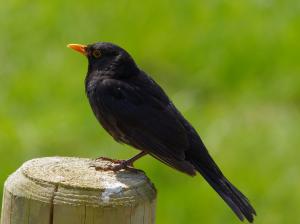


An abundant resident in Nottinghamshire, and ubiquitous in habitat. There is some seasonal movement of rural Blackbirds, suburban birds probably move little. Some ringing records in Nottinghamshire from the east coast of England suggest immigration from abroad for the winter. An article in British Birds - V40 deduces from ringing records that British Blackbirds tend not to move far from their birthplace. They may move out for the winter, but will often return in the spring.
W J Sterland and Joseph Whitaker both stated that the Blackbird was a common bird in the second half of the nineteenth century.
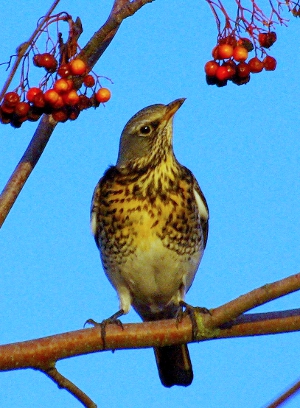
Very common winter visitor to Nottinghamshire, with the arrival being from mid-October. Their arrival times depend on the weather and the state of the Rowan crop in Scandinavia. Some years the arriving flocks can contain thousands of birds. They stay with us til the beginning of April. On arrival it feeds on berries from the hedges and in the early spring switches to foraging in pastures for invertebrates. If the supply of berries runs out and the weather turns cold then most Fieldfares will leave Nottinghamshire, passing through again on their way north, in the early spring.
From Sterland and Whitaker's writings the Fieldfare was common enough in the second half of the nineteenth century.
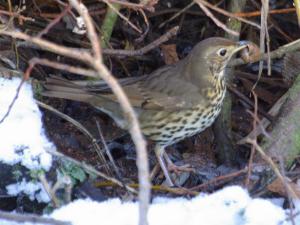
The Song Thrush is classed as a common resident in Nottinghamshire, with its liking for woodland edges, suburban parks and gardens and untidy hedges has plenty of choice here. It is more noticeable in the spring and early summer when the males are singing, but generally not too easy to see as it is a skulking feeder. The population can suffer in cold winters eg in 1962/3 the numbers nationally declined to 59% of their former level, but had recovered by 1968.
Song Thrush numbers declined dramatically nationally between 1970 and 1989 (British Birds - V96). The reasons for this are unknown. The numbers have increased somewhat since the late 1990s.
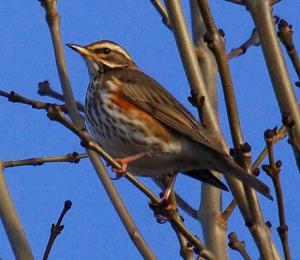
Sterland (Birds of Sherwood Forest{1869}) said the Redwing was "a regular winter visitor, associating in large flocks," in Nottinghamshire. Today it is still a very common winter visitor with the main arrivals from mid-October and leaving by early April. Constant east winds in spring can hold back the Redwing's departure and in times like these they can be heard singing.
The Redwing feeds on berries and fruit when it arrives in Nottinghamshire in mid-autumn. It will switch to earthworms when these supplies are exhausted. The Redwing also spends time in the woodland amongst the leaf litter, unlike the Fieldfare.
The Redwing was one species of bird which has been investigated to test (PDF document) whether stable isotopes can provide a way to determine the origins of migrating birds.
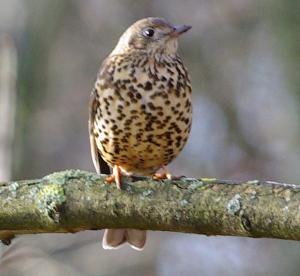
Mistle Thrushes like open areas, such as large parks and suburban gardens, farmland with a mosaic of hedgerows, scattered trees and open fields and so it is a common resident in Nottinghamshire. Mistle Thrushes are notable for their behaviour in defending fruit trees and berry supplies in winter. This is done by the adults, the young of the year depart the area (Atlas of Wintering Birds in Britain and Ireland {1986, Peter Lack}). There is some immigration from Europe in the winter.
Spread northwards in the early nineteenth century (Handbook of the Birds of the Western Palearctic), but unsure how this affected Nottinghamshire. Sterland in his (Birds of Sherwood Forest{1869}) described the Mistle Thrush as "very common, and in the winter frequents the forest and parks in large flocks".
Any criticisms, corrections or comments to the author Derek Huskisson

This work is licensed under a Creative Commons Attribution-Noncommercial-Share Alike 2.0 UK: England & Wales License.